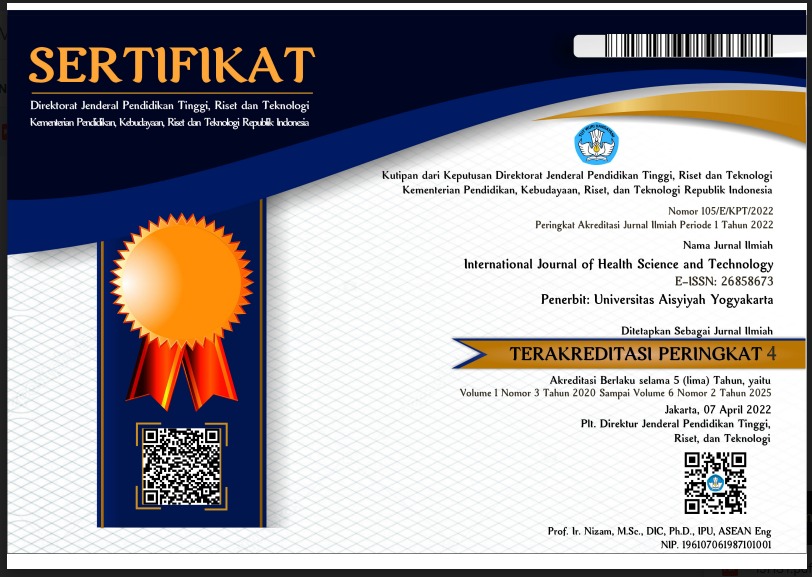Analysis and visualization of BPJS on twitter using K-means clustering
DOI:
https://doi.org/10.31101/ijhst.v3i3.2466Abstract views 464 times
Keywords:
BPJS, health, K-means, clusteringAbstract
References
A. Bastian, H. Sujadi, and G. Febrianto, “Penerapan Algoritma K-Means Clustering Analysis Pada Penyakit Menular Manusia (Studi Kasus Kabupaten Majalengka),†no. 1, pp. 26–32.
Abdullah, D., Susilo, S., Ahmar, A. S., Rusli, R., & Hidayat, R. (2021). The application of K-means clustering for province clustering in Indonesia of the risk of the COVID-19 pandemic based on COVID-19 data. Quality & Quantity, 1-9.
Ahmar, A. S., Napitupulu, D., Rahim, R., Hidayat, R., Sonatha, Y., & Azmi, M. (2018, June). Using K-Means Clustering to Cluster Provinces in Indonesia. In Journal of Physics: Conference Series (Vol. 1028, No. 1, p. 012006). IOP Publishing.
Ahmed, M., Seraj, R., & Islam, S. M. S. (2020). The k-means algorithm: A comprehensive survey and performance evaluation. Electronics, 9(8), 1295.
A. S. Jati, “Jumlah pengguna twitter meningkat†04 Mei, 2020.
A. Sani, “Penerapan Metode K-Means Clustering Pada Perusahaan,†J. Ilm. Teknol. Inf., no. 353, pp. 1–7, 2018.
D. H. Rarasati, “Dampak Kenaikan Tarif Bpjs Kesehatan terhadap pelayanan Kesehatan di Kota Malang,†J. Polit. Muda, vol. 6, no. 1, pp. 34–40, 2017.
D. C. Manning, P. Raghavan, and H. Schutze, An Introduction to Information Retrieval. 2009.
Elisawati, D. Wahyuni, and A. Arianto, “Analisa Clustering Pada Data Pelanggaran Lalulintas Di Pengadilan Negeri Dumai Dengan Menggunakan Metode K-Means,†JISKA (Jurnal Inform. Sunan Kalijaga), vol. 3, no. 3, pp. 50–61, 2019.
G. Gustientiedina, M. H. Adiya, and Y. Desnelita, “Penerapan Algoritma K-Means Untuk Clustering Data Obat-Obatan,†J. Nas. Teknol. dan Sist. Inf., vol. 5, no. 1, pp. 17–24, 2019.
H. Siqueira and F. Barros, “A Feature Extraction Process for Sentiment Analysis of Opinions on Services,†Proc. III Int. Work. Web Text Intell., 2010.
Kuswandi, D., Surahman, E., Thaariq, Z. Z. A., & Muthmainnah, M. (2018, October). K-Means clustering of student perceptions on project-based learning model application. In 2018 4th International Conference on Education and Technology (ICET) (pp. 9-12). IEEE.
Kansal, T., Bahuguna, S., Singh, V., & Choudhury, T. (2018, December). Customer segmentation using K-means clustering. In 2018 international conference on computational techniques, electronics and mechanical systems (CTEMS) (pp. 135-139). IEEE.
M. Habibi and P. W. Cahyo, “Clustering User Characteristics Based on the influence of Hashtags on the Instagram Platform,†IJCCS (Indonesian J. Comput. Cybern. Syst., vol. 13, no. 4, p. 399, 2019.
N. I. Febianto and N. Palasara, “Analisa Clustering K-Means Pada Data Informasi Kemiskinan Di Jawa Barat Tahun 2018,†J. Sisfokom (Sistem Inf. dan Komputer), vol. 8, no. 2, p. 130, 2019.
N. Putu, E. Merliana, and A. J. Santoso, “Analisa Penentuan Jumlah Cluster Terbaik pada Metode K-Means,†pp. 978–979.
P. Studi et al., “PENERAPAN ALGORITMA K-MEANS CLUSTER ING SEBAGAI STRATEGI PROMOSI PENERIMAAN MAHASISWA BARU PADA UNIVERSITAS HASYIM ASY ’ ARI JOMBANG Aries Dwi Indriyanti Indana Lazulfa,†vol. 04, pp. 20–27, 2020.
P. W. Cahyo, P. Studi, T. Informatika, U. Jenderal, and A. Yani, “KLASTERISASI TIPE PEMBELAJAR SEBAGAI PARAMETER Abstrak Data Collection,†pp. 49–55, 2018.
U. A. Nasron and M. Habibi, “Analysis of Marketplace Conversation Trends on Twitter Platform Using K-Means,†Compiler, vol. 9, no. 1, pp. 51–61, 2020.
Sinaga, K. P., & Yang, M. S. (2020). Unsupervised K-means clustering algorithm. IEEE access, 8, 80716-80727.
Syakur, M. A., Khotimah, B. K., Rochman, E. M. S., & Satoto, B. D. (2018, April). Integration k-means clustering method and elbow method for identification of the best customer profile cluster. In IOP conference series: materials science and engineering (Vol. 336, No. 1, p. 012017). IOP Publishing.
Yuan, C., & Yang, H. (2019). Research on K-value selection method of K-means clustering algorithm. J, 2(2), 226-235.
Downloads
Published
How to Cite
Issue
Section
License
International Journal of Health Science and Technology allows readers to read, download, copy, distribute, print, search, or link to its articles' full texts and allows readers to use them for any other lawful purpose. The journal allows the author(s) to hold the copyright without restrictions. Finally, the journal allows the author(s) to retain publishing rights without restrictions
- Authors are allowed to archive their submitted article in an open access repository
- Authors are allowed to archive the final published article in an open access repository with an acknowledgment of its initial publication in this journal

This work is licensed under a Creative Commons Attribution-ShareAlike 4.0 Generic License.










